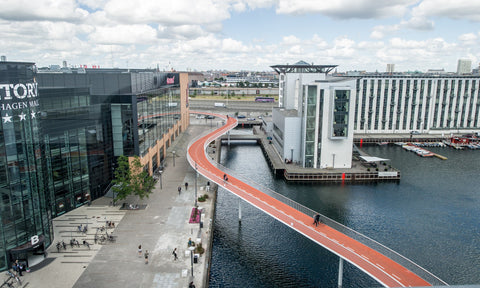
As we wade back into the world of travelling and borders have opened up for tourists around the world, we wanted to explore some of the most sustainable destinations, and specifically what they are doing differently to be so green.

One Central Park's living green facade exhibits 250 species of native Australian flowers and plants - Sydney, Australia
With the rise of eco-tourism in recent years, countries around the world have had to rethink how to make their cities more environmentally friendly. Initiatives in sectors like transportation, hospitality, and urban planning have shown extraordinary results around the world, most notably in the top 5 most environmentally responsible cities in the world (according to the Statista ranking of 2021):
1. Stockholm, Sweden
2. Copenhagen, Denmark
3. Sydney, Australia
4. Melbourne, Australia
5. Vienna, Austria
How green can transportation get?
Thanks to large investments and focus on this initiative, these cities were able to convert their public transit systems from diesel to electric. Stockholm, named greenest city in 2022, and Sydney both use energy made from 100% renewable sources like biofuel, wind, and solar power. Copenhagen, ranked 2nd most eco-friendly city in the world, is following in their footsteps making this conversion mandatory for all city buses.
These green cities have also developed cycling tracks and pedestrian areas to encourage their citizens to find alternative methods of getting around. Stockholm has around 900 km of bicycle lanes and plenty of cheap bikes available for rental. The same goes for Copenhagen, where less than 30% of households own a car.

Cycling infrastructure - Copenhagen, Denmark
Eco-tourism: the next best thing
The hospitality sector is another area that has seen massive improvements in terms of sustainability. Many of these cities have implemented environmental certification systems for hotels and tourist activities. For example, more than 60% of hotels in Copenhagen and more than 80% in Stockholm are eco-certified, meaning that they follow top standards for sustainable energy, food, and design. In Copenhagen, many restaurants and hotels use organic ingredients - even fast food restaurants!
These cities are made to provide an overall green experience which is reflected in their waste management systems. Copenhagen now has “reverse vending machines” scattered all over the city, making it easier than ever for citizens to profit from recycling containers that would otherwise go to landfill. Plastic water bottles are less of a problem in Copenhagen, as the tap water has been dubbed “the best tasting in the world”, and is actually preferred over bottled water for most citizens.
Vienna, taking full advantage of the benefits of eco-tourism, has developed green events and meetings that are certified by the Austrian Eco-label. The city promotes eco-friendly travel options to and from events, resulting in more than 780 events in the last 10 years being officially eco-certified.

A windfarm in Stockholm, Sweden
Smart cities with smart concepts
One thing all five cities have in common is extensive green spaces. Large investments have been put into either creating more green areas or maintaining them. Stockholm, has focused on dividing its natural and developed spaces proportionally to keep the city’s balance resulting in 2/3 of the city consisting of natural green spaces (parks and waterways) and 1/3 of developed land. Most impressively, 50% of the city of Vienna consists of green space.
Sustainably designed buildings have also brought these cities closer to their carbon neutral goals. For instance, Copenhagen’s famous landmark, Copenhill, is now a waste-to-energy power plant. The Stockholm-Arlanda airport is the first airport in the world to be accredited the highest level in a european program that grades the airports environmental impacts. Melbourne has also pursued new initiatives, launching in 2010 the 1200 Building Program aimed at remodelling older buildings to make them eco-friendly.

Greenspace in Vienna, Austria
Where will your travels take you in 2022?

















